Identifying Green Crystals: A Comprehensive Guide
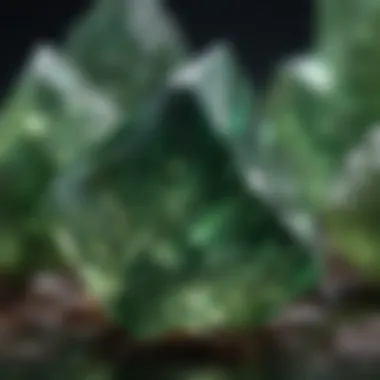
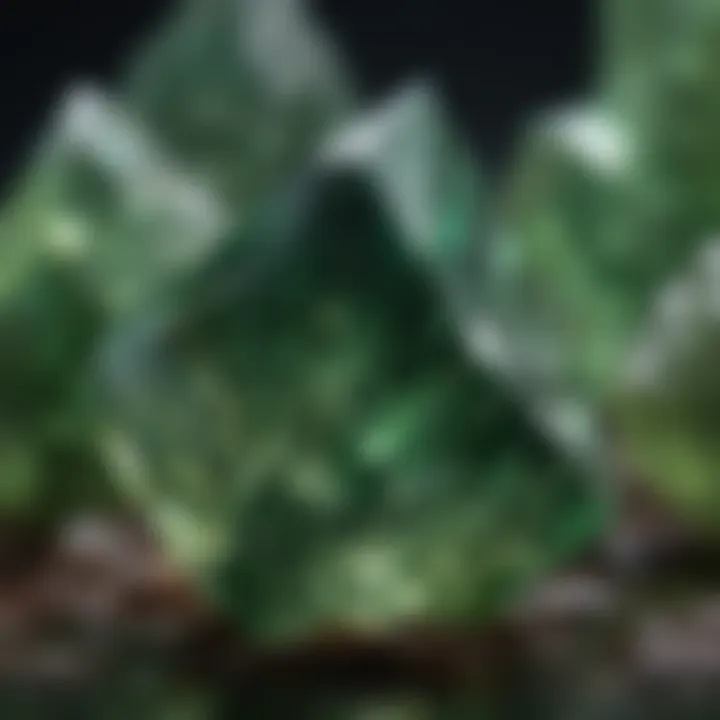
Intro
The world of green crystals is as fascinating as it is diverse. With shades that can range from deep emerald to soft pastel greens, these gemstones capture the eye and ignite the imagination. For rock and fossil collectors, identifying these stunning specimens involves more than just finding a pretty piece. It requires understanding their unique characteristics and historical context. Collectors often find connections beyond the mere physical attributes of each crystal, leading to a deeper appreciation for their geological formations and cultural significance.
In this guide, we will walk you through the multifaceted process of identifying green crystals. From discussing essential techniques and their visual traits to uncovering their historical narrative, we aim to provide you with a comprehensive framework that enhances your collection journey.
Featured Collectible of the Month
Overview
This month's highlight is the exquisite Peridot. Known for its vibrant green hue, Peridot is a silicate mineral that has held a special place in the hearts of collectors. Originating from volcanic activity, these crystals are believed to form deep within the Earth’s mantle, only to make their way to the surface through ancient eruptions.
Peridot's distinct color is attributed to iron, which gives it a yellowish-green tint in certain light conditions. This crystal isn’t just visually appealing; its charm lies in its rich lore and usability in jewelry-making. Mined predominantly in places like the United States, China, and even Afghanistan, the availability of Peridot adds to its allure.
Historical Significance
Historically, Peridot has been lauded since ancient times. The Egyptians were among the first to use this crystal, calling it the "gem of the sun." This gemstone has been associated with strength and power and was believed to ward off evil spirits. In many cultures, it serves as a symbol of beauty and serenity, further enhancing its desirability for collectors.
Understanding its historical importance can enrich your appreciation for Peridot as a collectible item, suggesting not just aesthetic value, but also cultural depth.
Identification Techniques
Visual Characteristics
Identifying green crystals may seem daunting at first glance, but certain visual traits can guide you. Pay attention to:
- Color Variations: While green is the primary color, the shades can differ vastly, signifying different types of minerals.
- Clarity and Transparency: Look for inclusions or cloudiness which may indicate the crystal's formation history.
- Texture: Some crystals like Aventurine may exhibit a glittery or sparkly appearance due to natural inclusions of mica.
- Shape and Cut: The crystallographic structure can often help narrow down which type of green crystal you are dealing with—whether it be cubic, hexagonal, or another formation.
Resources for Identification
To assist you in your identification journey, several resources stand out:
- Wikipedia: A broad reference for general knowledge on various minerals and their properties. Check out Wikipedia Mineralogy.
- Britannica: Another excellent source for in-depth articles on specific types of crystals and their significance in different cultures. Visit Britannica Crystals.
- Community Forums: Engaging with platforms like Reddit can provide insights from avid collectors who share experiences, identification tips, and personal anecdotes.
- Facebook Groups: Joining themed groups allows for real-time discussions and shared expertise, giving you direct access to seasoned collectors who can offer guidance.
Through careful observation of distinct characteristics and diligent use of identification resources, collectors can develop a robust understanding of green crystals. As you delve further into this captivating field, remember that each shade and formation tells a story unique to itself.
Intro to Green Crystals
Green crystals have captivated the imagination of collectors and enthusiasts alike, serving as a fascinating intersection of geology, history, and artistry. In this section, we aim to shed light on the importance of understanding green crystals and how they have carved out a niche in both the scientific and cultural realms. The nuanced exploration of these gemstones and minerals not only enhances the appreciation for their beauty but also provides insight into their unique properties and origins.
Understanding green crystals is not merely an exercise in aesthetics; it revolves around grasping their significance in various cultures, their historical implications, and their role in the ecosystem.
Definition and Importance
A green crystal typically refers to any mineral or gemstone that possesses a vivid or muted shade of green due to its unique chemical composition and crystalline structure. These hues range from the deep green of emeralds to the softer tones seen in jade. The importance of green crystals extends far beyond their visual appeal. They are often associated with themes of balance, nature, and harmony, making them popular choices for jewelry and as decorative pieces.
In many cultures, they are revered for their supposed healing properties and spiritual significance. This has led to a surge in interest from both collectors and those seeking to understand the metaphysical aspects of these natural wonders.
Historical Context
The historical context of green crystals is rich and multifaceted, echoing stories from ancient civilizations through to modern-day practices. For example, in ancient Egypt, green stones like emerald were highly prized, symbolizing fertility and rebirth. Pharaohs adorned themselves with these vibrant gems, believing they could offer protection and enhance spiritual connection.
The Chinese have a long history with jade, which is more than just a gemstone; it represents purity and moral integrity. Jade artifacts have been unearthed that date back thousands of years, often associated with funeral practices, underscoring its importance in cultural rituals.
In today's world, the revival of interest in these crystals is evident through the establishment of global mining initiatives and the relentless pursuit of sustainable sourcing. Many modern enthusiasts and collectors are not only drawn to the aesthetic value of the crystals but also their storied pasts, lending each specimen a layer of historical narrative that can be traced back through time.
"The color of the crystal is not just an aesthetic component; it encapsulates cultural narratives and personal meanings that resonate deeply with many people."
Physical Characteristics of Green Crystals
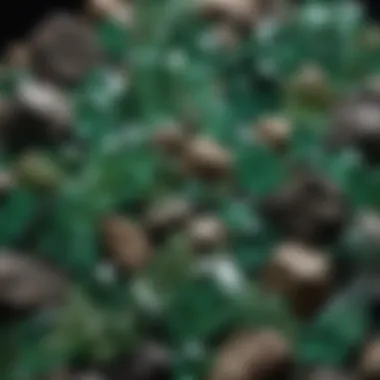
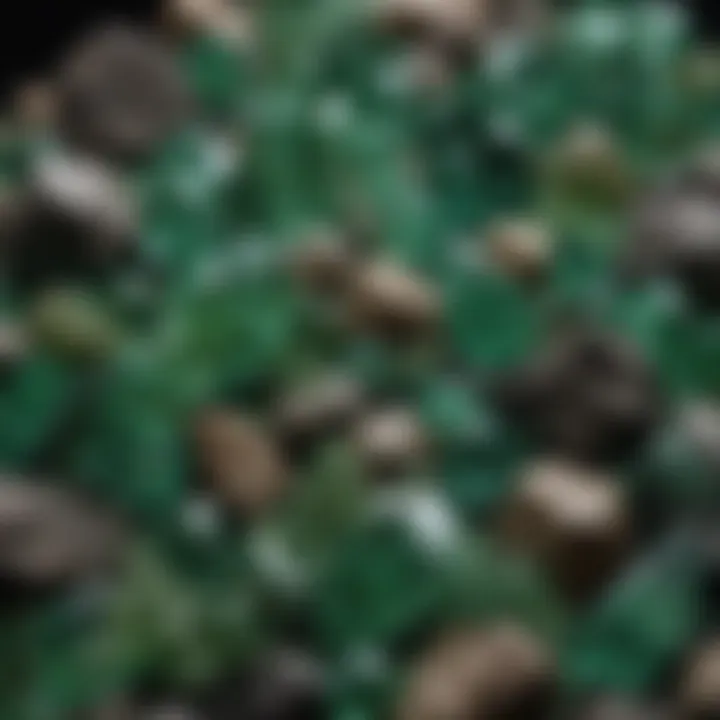
Understanding the physical characteristics of green crystals is crucial for anyone interested in identification and appreciation. These features not only distinguish one type from another, but they also narrate the story behind a crystal's formation and its journey through time. When collectors delve into the world of green crystals, recognizing these aspects can significantly enhance both their appreciation and their ability to identify specific specimens. Knowing how to observe color variations, clarity, transparency, and hardness offers a robust framework that can lead to more informed purchasing and collecting decisions.
Color Variations
Color variations in green crystals can be as varied as the leaves of a rainforest. Green hues might range from the deep, lush green of emerald to the pale mint shade of prehnite. Each shade tells its own tale, influenced by the mineral composition and the environmental conditions during formation.
- Emeralds, for instance, are known for their vibrant green color, often enriched by traces of chromium and vanadium.
- Jade, on the other hand, displays a softer palette that can include shades like apple green and dark green, resulting from its composition of jadeite or nephrite.
Color is not simply aesthetic; it can also indicate the presence of certain minerals. Collectors should pay attention to subtle hints in color tone when identifying crystals, as the right shade can pinpoint the specific type or quality level of the gem.
Clarity and Transparency
The clarity and transparency of a crystal can make or break its allure, particularly in the eyes of a collector. Clarity refers to the presence of internal inclusions or blemishes, while transparency explores how light interacts with the stone.
- Crystals like peridot can be quite clear, allowing the light to dance through it, making the green shimmer almost magical.
- Malachite, known for its striking banded appearance, will often have more opaque quality, which adds to its unique value.
Examining clarity and transparency doesn't just assist with identification; it also informs about the crystal's quality. More transparent stones with few inclusions tend to fetch higher prices and are desirable among collectors.
Hardness and Chemical Composition
The hardness of crystals is typically measured on the Mohs scale, with each mineral boasting its own distinct toughness. This is especially important for collectors who wish to assess both the durability and the potential use of the stone.
- Emerald, rated at a 7.5-8 on the Mohs scale, although it can be scratched easier due to its inclusions, can be valuable if found in excellent condition.
- Jade, typically ranking at about 6-7, showcases resilience, making it less prone to damage, which is an appealing trait for many collectors.
Chemical composition contributes to the hardness too. For example, the presence of certain elements can either strengthen or weaken the crystal. This aspect also helps in understanding its formation and potential uses in jewelry or as a decorative piece. The right balance of hardness and chemical structure is essential, as it can dictate how a crystal is utilized or cared for over time.
"The beauty of a crystal doesn't end its visual appeal; it extends to its physical properties that tell a wider tale."
Collectively, these characteristics enhance a collector's toolkit for identifying green crystals, enabling them to appreciate these treasures on a deeper level. Understanding these physical attributes is not merely an academic exercise; it grounds collectors in the real substance and origin of the vibrant green artifacts they seek.
Common Types of Green Crystals
Understanding the various types of green crystals is crucial for both enthusiasts and seasoned collectors. Each type possesses unique characteristics, historical significance, and uses that enhance its allure. This section provides an overview of some of the most sought-after green crystals, illustrating their distinctions and highlighting considerations for collectors.
Emerald
Emerald, a variety of beryl, is renowned for its vibrant green color, which can range from light green to deep green, often influenced by trace amounts of chromium and vanadium. It has been treasured for centuries, considered a symbol of rebirth and love. Historically, emeralds have been linked to royalty, with pharaohs and emperors cherishing them. When identifying emeralds, clarity is essential; they are often less transparent compared to other gems, which adds to their uniqueness.
Emerald: The green gem that embodies fertility and harmony.
Jade
Jade is a term that encompasses two distinct minerals: jadeite and nephrite. The former is rarer and more valuable, often exhibiting a more vibrant color. Jadeite typically ranges from deep emerald green to a pastel hue, while nephrite can appear more muted. Cultural significance runs deep with jade; it has been revered in Asian cultures, particularly in China, symbolizing wisdom, balance, and protection. Collectors often seek jade not only for its beauty but also for its rich folklore and historical uses in artifacts and ornamentation.
Peridot
Peridot, often referred to as the “evening emerald,” stands out due to its distinct yellowish-green hue. Its vibrant color is attributed to iron present in its olivine composition. Unlike other green gemstones, peridot is commonly found in volcanic rocks, which enhances its geological narrative. Ancient Egyptians believed it to be a stone of the sun, and its light-as-air quality offers a different feeling compared to denser crystals. Notably, peridot is often less expensive than emerald or jade, making it an appealing option for those emerging into the crystal collecting world.
Green Tourmaline
Green tourmaline showcases the diversity of green hues, ranging from deep forest green to light olive. Its special trait is the ability to exhibit multiple colors in one stone (known as watermelon tourmaline). Because of its pleochroism, which refers to its capacity to show different colors when viewed from different angles, it captivates both casual admirers and in-depth collectors. Green tourmaline is often associated with healing and positivity, making it a popular choice for many.
Malachite
Malachite is easily recognizable due to its striking banded patterns in varying shades of green. Formed from copper, its unique swirled appearance not only makes it visually captivating but also provides insightful geological history. Ancient civilizations prized malachite for its protective qualities and used it in decorative pieces, sculptures, and amulets. For collectors, its abundant presence in Africa and the Middle East means it’s relatively accessible, providing an entry point into the world of crystal collecting. Additionally, malachite is often used in jewelry and interior design due to its aesthetic appeal.
Identification Techniques
Understanding how to identify green crystals is crucial for collectors. The gem world is vast, and misidentifying stones can lead to frustration and financial loss. This section delves into the essential techniques that can empower collectors to distinguish between authentic specimens and imitations. Each technique has its strengths and specific uses, and mastering them allows one to gain confidence in their collection journey.
Visual Examination
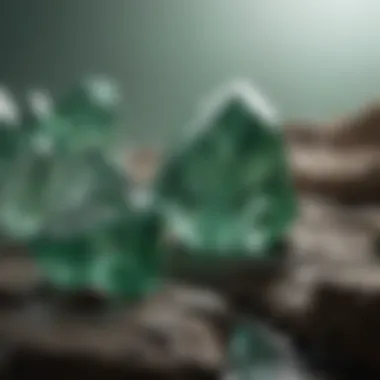
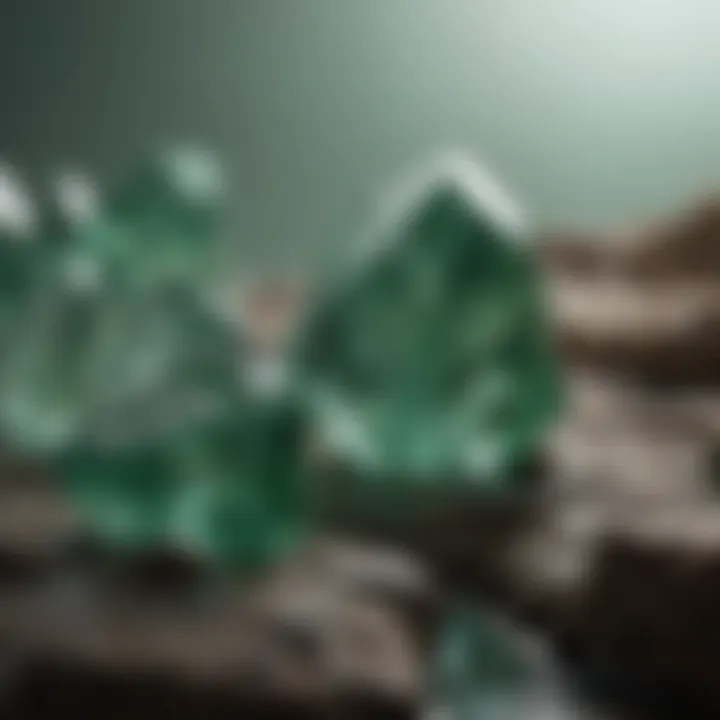
Visual examination serves as the initial step in identifying green crystals. A well-trained eye can pick up subtle differences that separate one stone from another—even if they look similar at first glance. Start by examining the color, which can vary widely depending on the type of crystal; some may be a deep emerald green, while others lean towards a mint shade. Color zoning, or the presence of lighter and darker patches, might indicate the natural origin of the stone. You should also note the luster—is it glassy, dull, or waxy? These traits provide clues as to what type of crystal you’re dealing with.
In addition to color and luster, take note of any inclusions, which are internal features like bubbles or flecks that can give away a crystal’s authenticity. Assigning these features to specific crystals contributes to a robust identification process.
Utilizing a Loupe
Using a loupe is akin to being handed a secret key to unlock more secrets of each crystal. A 10x jeweler’s loupe enhances minute details, revealing inclusions and structural patterns that the naked eye often misses. Such details are crucial; for instance, the microscopic structure of Malachite featuring its distinct banding can be easily overlooked.
When using a loupe, hold the crystal under good lighting to accentuate the features you’re observing. Pay attention to the surface textures—is it smooth or rough? Any scratches could indicate a soft stone that doesn't hold up well over time.
Testing for Hardness
The Mohs scale of mineral hardness is a classic tool in the gem collector's arsenal. Understanding hardness helps you determine a stone's durability and aids in its identification. For instance, a piece of jade will scratch glass while an emerald won’t; knowing these thresholds offers a way to distinguish between similar-looking stones. To perform a hardness test effectively, use common household items like a steel knife or a piece of quartz.
Always remember the basic rules:
- 1 to 3: Soft (easily scratched)
- 4 to 5: Moderate hardness
- 6 to 10: Hard stones (resistant to scratches)
Utilizing these techniques not only increases the accuracy of identification but also fosters a deeper appreciation for the geological beauty of the green crystals. It transforms the quest from mere collecting into a journey of discovery.
"It’s not just about owning crystals; it’s about understanding their stories."
Mastering these identification techniques will serve you well in your collecting venture. In the next sections, we will explore geological origins, cultural significance, and more to enhance your knowledge base.
Geological Origin of Green Crystals
Understanding the geological origin of green crystals is like piecing together a giant jigsaw puzzle. Each crystal tells a story not just of its physical properties, but also of the elements that shaped it, both literally and figuratively. The formation processes and their common locations play a significant role in how these crystals are identified and valued. For collectors, knowing where and how these crystals form enhances their appreciation and showcases the intricate dance between nature’s forces and mineral formation.
Formation Processes
The formation of green crystals can be quite intricate and varies based on a range of geological conditions. In many instances, these gemstones arise from metamorphic processes, where existing rocks are transformed under intense heat and pressure. For instance, emerald, a well-known green crystal, forms in schist or phyllite, where beryllium-rich fluids interact with minerals like aluminum and often result in the stunning, green-hued gem.
Another process involves crystallization from a molten state, where certain minerals, like peridot, crystallize from magma. The mineral olivine, which is responsible for peridot’s rich green color, emerges as magma cools and solidifies, often found deep within the Earth’s mantle.
Additionally, some green crystals, like malachite, are formed through weathering processes and oxidation. The interaction of copper ores with carbonated water leads to malachite's formation, maintaining its distinct green tint.
"Each type of green crystal carries a unique narrative rooted in its geological past, making them not just objects of beauty, but also pieces of Earth's history."
Common Locations
The locations where green crystals can be found are as varied as the formations themselves. Here’s a glimpse at a few prominent locales:
- Colombia: Home of the finest emeralds. The Muzo and Chivor mines are particularly renowned for their high-quality gems.
- Myanmar: Well known for jade, especially the imperial jade, which is cherished for its deep, vibrant green color.
- Hawaii: An unexpected source for olivine, which can be found in the beaches in its natural state, often referred to as “Hawaiian diamond.”
- Democratic Republic of the Congo: The region produces extensive quantities of malachite, often found in vivid, banded patterns.
- United States: Various locales, such as Arizona, reveal deposits of peridot and other green minerals, showcasing rich geological diversity.
When hunting for green crystals, an understanding of these locations not only helps in sourcing, but can also lend insight into the unique characteristics and quality of the crystals found there. The more you gather about their origins, the richer the narrative behind your collection.
Cultural Significance of Green Crystals
Understanding the cultural significance of green crystals is fundamental to appreciating their multifaceted value beyond mere aesthetics. These captivating stones have been woven into the fabric of societies for millennia, influencing beliefs, practices, and artistic expressions. When collectors engage with green crystals, they’re not just handling objects; they are connecting with history, traditions, and symbolic meanings attributed across various cultures.
Symbolism in Various Cultures
The color green often symbolizes growth, renewal, and harmony, which explains why many civilizations have revered green crystals as powerful talismans. For instance, in ancient Egypt, green stones like emeralds were associated with fertility and rebirth, connecting the crystals to the divine. They were often placed in tombs as a form of protection in the afterlife.
In Eastern philosophies, jade holds immense cultural weight. Regarded as a stone of purity and serenity, jade has been celebrated in Chinese culture not just for its beauty but also for its connection to virtue and wisdom. It’s considered an essential component in spiritual practices, embodying the notions of balance and stability.
Moreover, in Native American cultures, green crystals are often linked to the heart chakra. They are thought to facilitate emotional healing and foster a connection to nature, enhancing one's ability to transcend personal issues and embrace a broader perspective on life.
"Green crystals carry energies that resonate deeply with the earth, inviting us to reflect on our roots and connection to the natural world."
Uses in Jewelry and Art
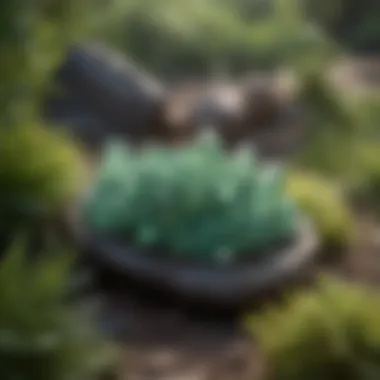
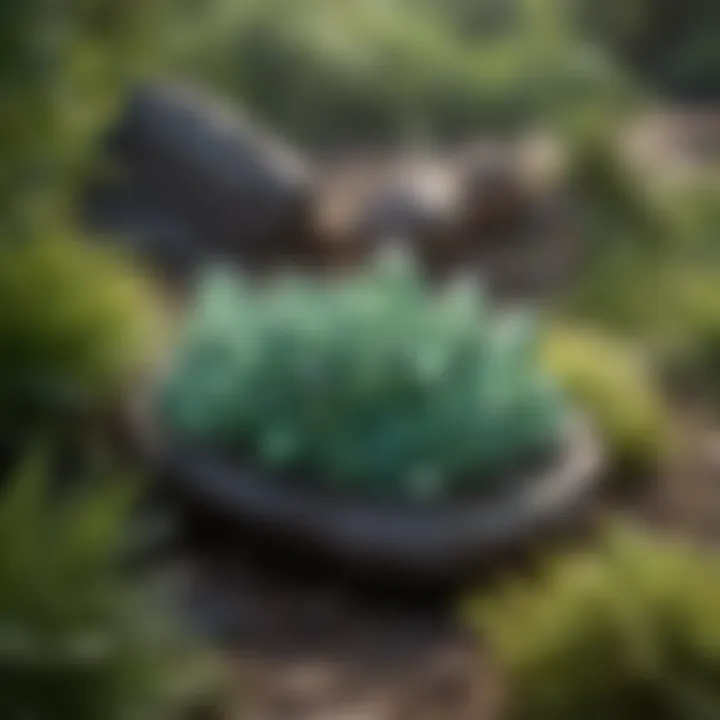
The allure of green crystals does not stop at their symbolism; their practical application in jewelry and art further amplifies their significance. These stones have graced the adornments of royalty and common folk alike across the ages.
- Emeralds, with their rich green hues, have been favorites in royal crowns and necklaces, serving not only as indicators of wealth but also as protectors against misfortune.
- Jade, often carved into intricate designs, holds special places in jewelry and ceremonial items, showcasing craftsmanship that tells stories of cultural heritage.
- Malachite, known for its striking bands of color, has been employed in sculptures and decorative items, often symbolizing the beauty of transformation and adaptability.
Collectors today often seek out these materials not just for their natural beauty but also for the resonance they hold with different cultures. Preserving and wearing these stones can be a way of acknowledging their rich histories and the enduring messages they convey.
Through both symbolic expression and functional art, crystal collectors can appreciate how green crystals serve as a bridge between nature and humanity, transcending their physical forms to embody meanings that reflect our deepest aspirations and connections.
Care and Preservation of Green Crystals
Caring for green crystals is essential not only for maintaining their beauty but also for preserving their value. These natural wonders, often representing thousands of years of geological history, can be sensitive to their environment. Understanding how to properly clean and store your crystals can make a world of difference in how they endure over time. Missteps in care can lead to damage, dulled finishes, or even irreversible harm. Here’s a closer look at how to keep these mesmerizing pieces in peak condition.
Cleaning Methods
Maintaining the luster and clarity of green crystals requires specific cleaning methods tailored to their unique properties. Here are some commonly recommended approaches:
- Gentle Soap Wash: Mix a few drops of mild dish soap in lukewarm water. Using a soft brush or cloth, dab the solution onto the crystal's surface, being careful not to scrub vigorously. Rinse with clean water to remove any soap residue and pat dry with a lint-free cloth.
- Natural Solutions: For stubborn stains or to refresh the crystal’s appearance, use a paste of baking soda and water. Just apply it to the affected area, gently scrub, and rinse thoroughly afterward.
- Avoid Harsh Chemicals: It’s important to steer clear of bleach, ammonia, or other abrasive cleaners. These substances can cause etching or discoloration in stones like jade or malachite.
- Moisture Caution: Shiny crystals, such as emeralds, may tolerate water but avoid soaking them for extended periods. Instead, quick cleaning is best.
Tip: Always test any cleaning method on a small, inconspicuous area first to ensure it doesn’t harm the stone.
Proper Storage Techniques
How and where you store your green crystals greatly affects their longevity. Here are some fine points to consider for optimal storage:
- Soft Pouch or Box: Keep your crystals in soft cloth bags or lined boxes to prevent scratches. The interior should be gentle, as hard materials can inflict damage.
- Avoid Sunlight: Prolonged exposure to sunlight can fade the vibrant colors of certain stones. Store them away from windows or in dark settings when not displayed.
- Separate Storage: Do not store different types of stones together. Mixing harder crystals with softer ones can lead to scratching and chipping. Instead, keep them spaced apart to maintain their integrity.
- Temperature Control: High heat or sudden temperature changes can cause fractures or other damage. Aim for a cool, stable environment.
- Regular Inspections: Take the time to inspect your crystals periodically. Look for any signs of wear, such as scratches or discoloration, so you can address any issues promptly.
By implementing these cleaning methods and storage tips, collectors can ensure that their precious green crystals not only retain their stunning looks but also preserve their metaphysical and historical significance for years to come.
Collecting Green Crystals
The act of collecting green crystals is much more than just a hobby; it is a pursuit that intertwines science, art, and a touch of personal narrative. This section aims to examine the significance of collecting these vivid gems and how the process can be both rewarding and enriching for enthusiasts and collectors alike.
When embarking on the journey of collecting green crystals, one learns to appreciate the intricate details that make each piece unique. The allure lies in the colors, formations, and the stories behind their origins—attributes that speak volumes in connecting to the broader elemental world. Such collections can serve as both a visual delight and an educational platform. Through extensive research to understand each crystal's properties and histories, collectors hold a miniature slice of the earth's geologic timeline.
Strategies for New Collectors
Stepping into the world of green crystals can feel like diving into an ocean of possibilities. Here are some strategies that can simplify this exhilarating journey for newcomers:
- Join Collector Communities: Engaging with groups on platforms such as reddit.com or social media can provide valuable insights. Fellow collectors often share tips on where to find the best specimens.
- Visit Mineral Shows and Fairs: Such events are treasure troves, showcasing a wide variety of green crystals. Connecting with vendors allows for both the acquisition of unique pieces and a chance to learn about them firsthand.
- Research and Education: Familiarizing oneself with common types of green crystals like emeralds and jade through resources such as wikipedia.com or books can provide context, allowing collectors to make informed purchases.
- Start Small: Investing in smaller or more commonly found specimens can ease the financial burden while building the collection. It provides a solid foundation for deeper exploration later.
- Document Findings: Keeping a journal of each stone's details—its type, location found, and any special characteristics—creates a personal reference and adds depth to the collection.
Finding Rare Specimens
Hunting for rare green crystals is where the thrill of collecting truly shines. Discovering these elusive stones can feel like finding buried treasure. Here are several approaches to consider:
- Local Geology: Understanding the geological composition of your area can be advantageous. Many regions are rich in specific minerals, and conducting field trips can sometimes yield surprising finds.
- Networking: Building relationships with seasoned collectors can open doors to private collections and exclusive sales, potentially leading to rare specimen finds.
- Monitor Online Marketplaces: Websites and forums can frequently offer listings for rare crystals. Regular searches on platforms like facebook.com can enrich your collection.
- Trip Planning: Consider planning trips to well-known mining areas or sites famous for specific crystals. Locations with historical significance might offer an opportunity to unearth unique finds.
End
Understanding how to identify green crystals is not just a beneficial skill for collectors; it enriches the entire experience of enjoying and appreciating these natural wonders. The process involves several key elements, including recognizing physical characteristics, mastering various identification techniques, and grasping the cultural significance behind each specimen.
Through sharp attention to details like color variations, clarity, and hardness, collectors can make informed decisions that enhance their collections. This enriches one’s connection to the earth and history, as many of these crystals have fascinating geological backstories tied to their formation and location.
Summarizing Key Points
As we summarize the core aspects addressed in this guide, it’s evident that:
- Color and Clarity: The hue and transparency of green crystals often dictate their value and appeal as collection pieces.
- Identification Techniques: Visual examinations combined with tools like loupes and hardness tests play a pivotal role in accurately distinguishing between different types of green crystals.
- Cultural Insights: Each crystal type carries unique symbolic meanings across various cultures, which adds another layer of appreciation for collectors.
- Care Practices: Proper cleaning and storage methods ensure that each specimen retains its brilliance for years to come.
These points not only serve as a foundation for identification but also enrich one’s overall journey in the world of rock and fossil collecting.
Future Trends in Crystal Collecting
Looking ahead, the world of crystal collecting is bound to evolve. Here are some aspects to keep an eye on:
- Sustainable Sourcing: As more individuals become environmentally conscious, collectors may prioritize crystals that come from responsible sources, ensuring that mining practices are not harmful to the environment.
- Technology Integration: Innovations like virtual reality (VR) might make it possible to experience the beauty of these crystals digitally, allowing potential buyers to inspect them without having to be physically present.
- Education and Community: Online platforms will likely expand, offering more resources and community connections for both new and seasoned collectors. This could foster a vibrant exchange of knowledge and ideas related to green crystals.
- Emerging Trends: With the rise of interest in alternative healing practices, crystals will continue to play a significant role in holistic lifestyles, which might lead to an increase in demand and new types of crystals being sought out.
In essence, the landscape of crystal collecting is dynamic, driven by both ethical considerations and technological advancements. Collectors who stay in the loop will likely find achievable success while enriching their understanding of these beautiful gems.



